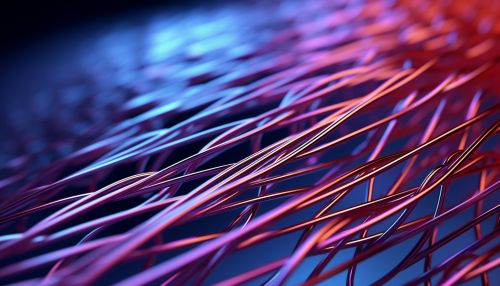Nanowires
Introduction
Nanowires are a type of nanoscale material with a diameter on the order of a few nanometers (typically less than 100 nm) and an unconstrained length. They are characterized by their high aspect ratio, which is the ratio of their length to their width. Nanowires can be composed of a variety of materials, including metals, semiconductors, and insulators, and can exhibit a range of unique physical and chemical properties due to their nanoscale dimensions and high surface-to-volume ratio.


Fabrication
There are several methods for fabricating nanowires, including vapor-liquid-solid (VLS) growth, template-assisted synthesis, and electrospinning. The choice of fabrication method depends on the desired properties of the nanowires, such as their composition, diameter, length, and crystallinity.
Vapor-Liquid-Solid (VLS) Growth
The VLS growth method involves the reaction of a vapor-phase precursor with a liquid-phase catalyst to form a solid nanowire. This method is commonly used to fabricate semiconductor nanowires, such as silicon, germanium, and compound semiconductors.
Template-Assisted Synthesis
In the template-assisted synthesis method, a nanoporous template is used to guide the growth of the nanowires. The template is typically made of a material such as anodized aluminum oxide (AAO) or polycarbonate, and the nanowires are formed by depositing the desired material into the nanopores of the template.
Electrospinning
Electrospinning is a method that uses an electric field to draw charged threads of polymer solutions or polymer melts up to fiber diameters in the order of some hundred nanometers. Electrospinning is particularly useful for fabricating polymeric nanowires.
Properties
Nanowires exhibit a range of unique properties due to their nanoscale dimensions and high surface-to-volume ratio. These properties can be broadly classified into electrical, thermal, mechanical, and optical properties.
Electrical Properties
Nanowires can exhibit exceptional electrical properties, including high electron mobility, quantum confinement effects, and ballistic transport. These properties make nanowires promising for applications in nanoscale electronics and optoelectronics.
Thermal Properties
Nanowires can exhibit unique thermal properties, including reduced thermal conductivity and enhanced thermoelectric efficiency. These properties are of interest for applications in thermal management and energy harvesting.
Mechanical Properties
Nanowires can exhibit exceptional mechanical properties, including high tensile strength and flexibility. These properties make nanowires suitable for applications in flexible electronics and nanocomposites.
Optical Properties
Nanowires can exhibit unique optical properties, including enhanced light absorption and emission, waveguiding, and lasing. These properties make nanowires promising for applications in solar cells, light-emitting diodes (LEDs), and lasers.
Applications
Nanowires have potential applications in a wide range of fields, including electronics, optoelectronics, energy, medicine, and materials science.
Electronics and Optoelectronics
In the field of electronics and optoelectronics, nanowires can be used in the fabrication of nanoscale transistors, diodes, sensors, and photodetectors. They can also be used to enhance the performance of solar cells and light-emitting diodes (LEDs).
Energy
In the field of energy, nanowires can be used in the fabrication of thermoelectric devices for energy harvesting, and in the development of high-capacity anodes for lithium-ion batteries.
Medicine
In the field of medicine, nanowires can be used in the development of biosensors for disease detection, and in the delivery of drugs and genes for therapeutic applications.
Materials Science
In the field of materials science, nanowires can be used in the fabrication of nanocomposites with enhanced mechanical, electrical, and thermal properties.
